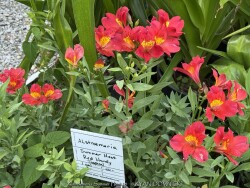

***Description for this hardy tropical available with future update!*** Alstroemeria 'Summer Heat' is also known as Summer Heat Red Hardy Alstroemeria >>>>>>>>>>> Plant delights nursery says "Alstroemeria 'Indian Summer' is a breeding breakthrough in garden quality alstroemerias. This amazing selection has sailed through both our trials for heat and humidity as well as winter hardiness trials in western Michigan (multiple winters of below -15 degrees F). Alstroemeria 'Indian Summer' emerges in spring with 3' tall purple-tinted stalks, clothed with grey purple foliage, and topped, starting in late spring, with terminal clusters of flowers. The flowers are composed of three orange petals, intermixed with three yellow petals with violet flecks. Flowering slows in the heat or summer, but resumes as night temperatures cool, and continues until frost. The effect of Alstroemeria 'Indian Summer' in the garden is truly stunning!"
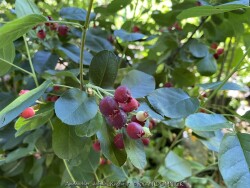

This serviceberry (Amelanchier alnifolia 'Regent') is a shrub to dwarf tree form with edible bluish-purple berry-like fruit, native to North America from Alaska across most of western Canada and in the western and north-central United States. Although it is adaptable to a variety of soil and moisture conditions, it shows some drought intolerance so go with sand plums on a drier site. The delicious fruit of this and related species are eaten fresh or prepared in puddings and pies. You need to act quick before the birds strip them clean. 'Regent' is a compact, deciduous, stoloniferous, early-flowering cultivar which typically grows only 4-6' tall. Great plant for the edible landscape!
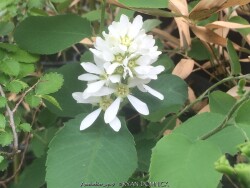

This serviceberry (Amelanchier canadensis) is a deciduous, early-flowering, large shrub or small tree which typically grows 15-25' tall with edible red to bluish-purple berry-like fruit. Native to Eastern North America. Although it is adaptable to a variety of soil and moisture conditions, it shows some drought intolerance so go with sand plums or American plums on a drier site. The delicious fruit of this and related species are eaten fresh or prepared in puddings and pies. You need to act quick before the birds strip them clean. Amelanchier canadensis is also called Shadblow Serviceberry. Great plant for the edible landscape!
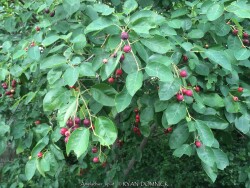

Serviceberry (Amelanchier sp.) can be a shrub or dwarf tree form with edible red to bluish-purple berry-like fruit, native to North America from Alaska across most of western Canada and in the western and north-central United States. Although it is adaptable to a variety of soil and moisture conditions, it shows some drought intolerance so go with sand plums on a drier site. The delicious fruit of this and related species are eaten fresh or prepared in puddings and pies. You need to act quick before the birds strip them clean. Great plant for the edible landscape!
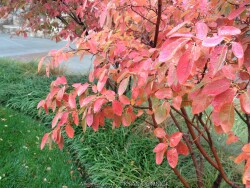

This serviceberry (Amelanchier x grandiflora 'Autumn Brilliance') is a deciduous, early-flowering, large shrub or small tree which typically grows 15-25' tall with edible red to bluish-purple berry-like fruit. Native to Eastern North America. Although it is adaptable to a variety of soil and moisture conditions, it shows some drought intolerance so go with sand plums or American plums on a drier site. The delicious fruit of this and related species are eaten fresh or prepared in puddings and pies. You need to act quick before the birds strip them clean. Amelanchier x grandiflora is a hybrid cross between two species of North American serviceberry, namely, A. arborea (downy serviceberry) and A. laevis (Allegheny serviceberry). 'Autumn Brilliance' has brilliant orange-red fall color. Great plant for the edible landscape!
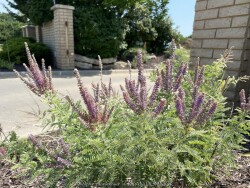

Leadplant (Amorpha canescens) is a small, deciduous perennial semi-shrub, 1-3 ft. tall, with tiny, purple flowers grouped together in colorful, terminal spikes with orange pollen. The blooming season is relatively short but the pinnately compound leaves offers lasting interest and a "Wow" factor. Leadplant can be found in many locations throughout North America but mostly in the midwest USA. Disjunct populations also exist in Texas, New Mexico and Colorado but skipping the fire-prone areas of the Great Plains. Leadplant is typically found in dry prairie pockets of land that are not overgrown, do not burn frequently, and experience minimal live-stock grazing. Leadplant grows best in drier, well-drained soil of many different textures including sandy, gravely, and rocky soils. Leadplant needs full sun for flowering and to avoid floppiness. Mainly used in Kansas landscapes in native prairie gardens, it tolerates considerable drought and alkaline limestone clay soils. It does best on a berm with great drainage or un-irrigated parking lot islands and "hell-strips". Leadplant has only one pest problem and that is rabbits! If rabbits are an issue, just put a bowl-shaped chicken wire cage around the plants for the first year. By year #2, the rapidly growing foliage will outgrow any detrimental rabbit browsing. This is definitely one of the most adapted native landscape shrubs in Kansas zone 6a with no problems with heat, cold, or drought! It's hard to imagine a native perennial garden without this plant! Butterflies will thank you!
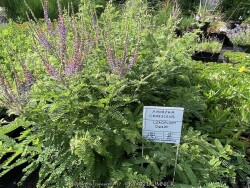

Leadplant (Amorpha canescens) is a small, deciduous perennial semi-shrub, 1-3 ft. tall, with tiny, purple flowers grouped together in colorful, terminal spikes with orange pollen. The blooming season is relatively short but the pinnately compound leaves offers lasting interest and a "Wow" factor. Leadplant can be found in many locations throughout North America but mostly in the midwest USA. Disjunct populations also exist in Texas, New Mexico and Colorado but skipping the fire-prone areas of the Great Plains. Leadplant is typically found in dry prairie pockets of land that are not overgrown, do not burn frequently, and experience minimal live-stock grazing. Leadplant grows best in drier, well-drained soil of many different textures including sandy, gravely, and rocky soils. Leadplant needs full sun for flowering and to avoid floppiness. Mainly used in Kansas landscapes in native prairie gardens, it tolerates considerable drought and alkaline limestone clay soils. It does best on a berm with great drainage or un-irrigated parking lot islands and "hell-strips". Leadplant has only one pest problem and that is rabbits! If rabbits are an issue, just put a bowl-shaped chicken wire cage around the plants for the first year. By year #2, the rapidly growing foliage will outgrow any detrimental rabbit browsing. This is definitely one of the most adapted native landscape shrubs in Kansas zone 6a with no problems with heat, cold, or drought! It's hard to imagine a native perennial garden without this plant! Butterflies will thank you!


False Indigo Shrub (Amorpha fruticosa) is a 6-10 ft., loose, airy shrub which often forms dense thickets. The blooming season is relatively short but the pinnately compound leaves offers lasting interest and a "Wow" factor. The foliage is pinnately compound, fine-textured, and turns gold in the fall lasting for a week or two. Older plantings may be rejuvenated as they do develop a leggy character with the majority of their foliage on the upper third of the plant. This is a species of flowering plant in the legume family Fabaceae so it is able to make its own nitrogen. False Indigo Shrub tolerates many types of soil including wet sandy soils. Other names include desert false indigo, false indigo-bush, and bastard indigobush. It is native to North America and has potential to be invasive in parts of the country but not so much in Kansas.
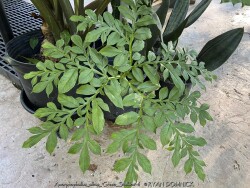

***Description for this hardy tropical available with future update!*** Amorphophallus albus 'Green Stalkings' is also known as Green Stalkings / Amorphophallus >>>>>>>>>>> Plant Delights Nursery says "This little-known but easy-to-grow voodoo lily is native to the Yunnan Province of China. The stalks are either solid green or green with grey spots and are each topped with a glossy green leaf. Amorphophallus albus is a fast offsetting species that forms a nice 2' wide patch (in 5 years) in the woodland garden. In spring, just as the leaf emerges, a 1' tall flower stalk appears alongside it with a 6-8" tall flower perched on top. Each flower resembles a large ivory shell showcasing a white, cigar-like appendage...green at the tip and white at the base." >>>>>>>>>> Voodoo (Amorphophallus konjac) lily is a perennial tuber generally grown as a curiosity for its interesting foliage. The single leaf consists of a stalk (petiole) with mottled pinkish-gray and olive green coloration. The single intricate leaf has horizontal sections giving it a tropical umbrella-like effect. Larger tubers (about the size of a grapefruit or larger) may produce a single "flower" in spring before the foliage appears. The "flower" is actually a large shiny purple to maroon ruffled spathe. When in bloom it produces an odor like a dead animal for 1 day. This is intended to attract the carrion flies that are its natural pollinators. It is possible to overwinter these in the ground in Kansas by placing a 6-12" mound of mulch over deeply planted tubers. New growth will usually be delayed until June but quickly regains full height and will get bigger each year; buried tubers are hardy to zone 6a. They can also be grown as a flowering summer patio plant. If growing as a potted plant and trying to overwinter, allowing the foliage to frost is ok, it will not kill the root system. However, do not allow the pot with rootball to freeze solid or go below 20 degrees for more than a few hours; move into a cold garage or basement over the winter with no watering. Cut back and allow to go dormant and place entire pot back out in April or May with a time-release fertilizer. Plants can get huge and exotic looking as a potted patio plant. Grown in Japan and Korea as an edible corm. Testing in Lawrence KS display gardens has been successful; surviving temperatures of -11F (2024)
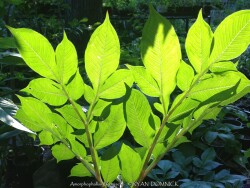

Voodoo (Amorphophallus konjac) lily is a perennial tuber generally grown as a curiosity for its interesting foliage. The single leaf consists of a stalk (petiole) with mottled pinkish-gray and olive green coloration. The single intricate leaf has horizontal sections giving it a tropical umbrella-like effect. Larger tubers (about the size of a grapefruit or larger) may produce a single "flower" in spring before the foliage appears. The "flower" is actually a large shiny purple to maroon ruffled spathe. When in bloom it produces an odor like a dead animal for 1 day. This is intended to attract the carrion flies that are its natural pollinators. It is possible to overwinter these in the ground in Kansas by placing a 6-12" mound of mulch over deeply planted tubers. New growth will usually be delayed until June but quickly regains full height and will get bigger each year; buried tubers are hardy to zone 6a. They can also be grown as a flowering summer patio plant. If growing as a potted plant and trying to overwinter, allowing the foliage to frost is ok, it will not kill the root system. However, do not allow the pot with rootball to freeze solid or go below 20 degrees for more than a few hours; move into a cold garage or basement over the winter with no watering. Cut back and allow to go dormant and place entire pot back out in April or May with a time-release fertilizer. Plants can get huge and exotic looking as a potted patio plant. Grown in Japan and Korea as an edible corm.


Blue Ice Amsonia (Amsonia 'Blue Ice') is a chance seedling from A. tabernaemontana which is native to North America. It bears gorgeous deep blue buds in late spring opening to vivid a periwinkle blue for about 4-6 weeks. The bright green foliage is compact and mostly pest-free. However in some years with high humidity and extra summer rainfall, the foliage gets diseased and should be cut back early. If in good air circulation, the foliage often turns a rich shade of yellow in fall characteristic of most amsonias. In Kansas Landscapes, it is usually planted as a mass groundcover growing into a dense weed proof mass. Established plants are low maintenance and almost never need to be replaced, divided or watered.
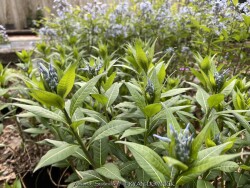

The species bluestar (Amsonia) grows up to 3 feet tall and prefers a medium to moist soil, but will tolerate a range of soils in light shade, including clay. "Once it's there, it's there forever" plant! Native to East-central U.S. in open woodlands and sunny plains. 'Storm Cloud' is and improved selection with new stems emerge near-black with leaves that are very dark green with silver veins. The stems stay dark throughout spring contrasting the light periwinkle blue, star-shaped flowers that completely cover the foliage by late spring. Some reblooming may occur for many weeks afterward. Although the main interest of this plant is in spring, it maintains a great garden presence throughout the summer and fall. Its wide, mounded habit lends itself well to be used in place of shrubs in the landscape. In some years with high humidity and extra summer rainfall, the foliage gets diseased and should be cut back early. Provide planting location with good air circulation to avoid this small problem. Compared to 'Storm Cloud', Amsonia 'Starstruck', a more compact version at 18", has wider leaves, and blooms about 1-2 weeks later in the spring. All Proven Winners® plants are legally propagated, healthy and vigorous, true to name, and tagged with color pictures and growing information.


Narrow-leaf Amsonia (Amsonia hubrichtii) is clump-forming plant that is primarily grown in cultivation for its feathery green summer foliage and golden fall color. Spring flowers are powdery blue rising on 3' stalks creating a compact dense willow-like bush. The blooming season is relatively short but the pinnately compound leaves offers lasting interest and a "Wow" factor. Rich golden fall color is long-lasting and dries remaining attractive deep into the winter. No deadheading is needed and the only maintenance is cutting the plant back each winter after the fall foliage is no longer attractive. In some years with high humidity and extra summer rainfall, the foliage gets diseased and should be cut back early. Provide planting location in full sun with good air circulation to avoid this small problem. The growth is so dense that no weeds have a chance of invading a mature stand of plants. Amsonia hubrichtii is relatively new to cultivation being discovered in Arkansas in 1942 but is hardy in zones 5-9. Combine with other summer or fall flowering plants like hardy hibiscus, crapemyrtle, or penstemon. Fine-textured foliage also combines well with dark foliage, larger leaves, and dark colored walls! Great for large-scale mass plantings needing something permanent. This is a true four-seasons long-lived perennial that belongs in almost every perennial garden. String Theory Narrow-leaf Amsonia (Amsonia 'String Theory') can be described as a compact version of the industry standard Amsonia hubrichtii. All Proven Winners® plants are legally propagated, healthy and vigorous, true to name, and tagged with color pictures and growing information.
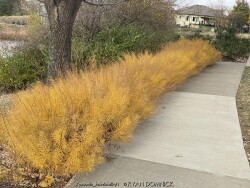

Narrow-leaf Amsonia (Amsonia hubrichtii) is clump-forming plant that is primarily grown in cultivation for its feathery green summer foliage and golden fall color. Spring flowers are powdery blue rising on 3' stalks creating a compact dense willow-like bush. The blooming season is relatively short but the pinnately compound leaves offers lasting interest and a "Wow" factor. Rich golden fall color is long-lasting and dries remaining attractive deep into the winter. No deadheading is needed and the only maintenance is cutting the plant back each winter after the fall foliage is no longer attractive. In some years with high humidity and extra summer rainfall, the foliage gets diseased and should be cut back early. Provide planting location in full sun with good air circulation to avoid this small problem. The growth is so dense that no weeds have a chance of invading a mature stand of plants. Amsonia hubrichtii is relatively new to cultivation being discovered in Arkansas in 1942 but is hardy in zones 5-9. Combine with other summer or fall flowering plants like hardy hibiscus, crapemyrtle, or penstemon. Fine-textured foliage also combines well with dark foliage, larger leaves, and dark colored walls! Great for large-scale mass plantings needing something permanent. This is a true four-seasons long-lived perennial that belongs in almost every perennial garden.
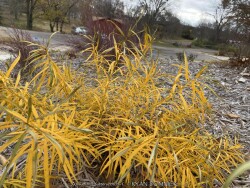

Narrow-leaf Amsonia (Amsonia hubrichtii) is clump-forming plant that is primarily grown in cultivation for its feathery green summer foliage and golden fall color. Spring flowers are powdery blue rising on 3' stalks creating a compact dense willow-like bush. The blooming season is relatively short but the pinnately compound leaves offers lasting interest and a "Wow" factor. Rich golden fall color is long-lasting and dries remaining attractive deep into the winter. No deadheading is needed and the only maintenance is cutting the plant back each winter after the fall foliage is no longer attractive. In some years with high humidity and extra summer rainfall, the foliage gets diseased and should be cut back early. Provide planting location in full sun with good air circulation to avoid this small problem. The growth is so dense that no weeds have a chance of invading a mature stand of plants. Amsonia hubrichtii is relatively new to cultivation being discovered in Arkansas in 1942 but is hardy in zones 5-9. Combine with other summer or fall flowering plants like hardy hibiscus, crapemyrtle, or penstemon. Fine-textured foliage also combines well with dark foliage, larger leaves, and dark colored walls! Great for large-scale mass plantings needing something permanent. This is a true four-seasons long-lived perennial that belongs in almost every perennial garden. Butterscotch Amsonia (Amsonia hubrichtii 'Butterscotch') is like other Amsonia in general appearance, but with improved form, reddish stems, superior rich "butterscotch" fall color, and great resistance to tip dieback. Flower color is also slightly darker blue.
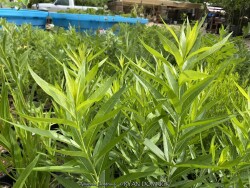

Shining bluestar (Amsonia illustris) grows up to 3 feet tall and prefers a medium to moist soil, but will tolerate a range of soils in light shade, including clay. "Once it's there, it's there forever" plant! Native to Central U.S. most frequently occuring in sandy or rocky soils on gravel bars or along streams. Because it tolerates periods of brief flooding, it is an ideal amsonia for the rain-garden. This is a great amsonia for foliage quality, bearing Narrow, willow-shaped, leathery, shiny green leaves.
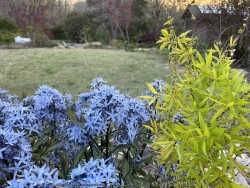

The species bluestar (Amsonia tabernaemontana) growing up to 3 feet tall and prefers a medium to moist soil, but will tolerate a range of soils in light shade, including clay. "Once it's there, it's there forever" plant! Native to East-central U.S. in open woodlands and sunny plains. Amsonia tabernaemontana 'Storm Cloud' is and improved selection with new stems emerge near-black with leaves that are very dark green with silver veins. The stems stay dark throughout spring contrasting the light periwinkle blue, star-shaped flowers that completely cover the foliage by late spring. Some reblooming may occur for many weeks afterward. Although the main interest of this plant is in spring, it maintains a great garden presence throughout the summer and fall. Its wide, mounded habit lends itself well to be used in place of shrubs in the landscape. In some years with high humidity and extra summer rainfall, the foliage gets diseased and should be cut back early. Provide planting location with good air circulation to avoid this small problem.
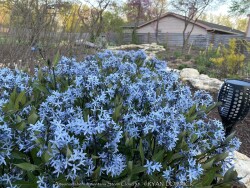

The species bluestar (Amsonia tabernaemontana) growing up to 3 feet tall and prefers a medium to moist soil, but will tolerate a range of soils in light shade, including clay. "Once it's there, it's there forever" plant! Native to East-central U.S. in open woodlands and sunny plains. Amsonia tabernaemontana 'Storm Cloud' is and improved selection with new stems emerge near-black with leaves that are very dark green with silver veins. The stems stay dark throughout spring contrasting the light periwinkle blue, star-shaped flowers that completely cover the foliage by late spring. Some reblooming may occur for many weeks afterward. Although the main interest of this plant is in spring, it maintains a great garden presence throughout the summer and fall. Its wide, mounded habit lends itself well to be used in place of shrubs in the landscape. In some years with high humidity and extra summer rainfall, the foliage gets diseased and should be cut back early. Provide planting location with good air circulation to avoid this small problem.
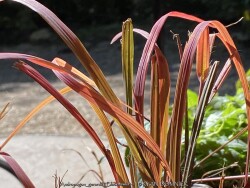

Big Bluestem (Andropogon gerardii 'Blackhawks') is easily grown in average, dry to medium, well-drained soils in full sun. It is tolerant of a wide range of soils and growing conditions but tends to flop in rich moist soils. This ornamantal grass is a tall, Kansas native, perennial, warm season grass that dominates much of the tall grass prairie extending into the Flint Hills. In fact, Big bluestem, Indiangrass, Little bluestem, and Switchgrass comprise 75% of the species in this ecosystem. It may be grown as an ornamental grass because of its attractive foliage which changes color seasonally along with its good architectural height and its interesting flower/seed heads. Andropogon gerardii 'Blackhawks' is primarily distinguished from the species by its slightly shorter height, deeper green summer foliage and blackish-purple fall color. An excellent garden performer with a clumping form and upright habit. Leaves emerge deep green with red highlights in spring, remain green through much of the summer, change to purplish-red to purple by late summer and finally turn a vivid scarlet red after first fall frost. Burgundy purple flowers bloom in August. Plants typically grow to 4-5' tall.


Big Bluestem (Andropogon gerardii 'Red October') is easily grown in average, dry to medium, well-drained soils in full sun. It is tolerant of a wide range of soils and growing conditions but tends to flop in rich moist soils. This ornamantal grass is a tall, Kansas native, perennial, warm season grass that dominates much of the tall grass prairie extending into the Flint Hills. In fact, Big bluestem, Indiangrass, Little bluestem, and Switchgrass comprise 75% of the species in this ecosystem. It may be grown as an ornamental grass because of its attractive foliage which changes color seasonally along with its good architectural height and its interesting flower/seed heads. Andropogon gerardii 'Red October' is primarily distinguished from the species by its slightly shorter height, deeper green summer foliage and brilliant scarlet red fall color. An excellent garden performer with a clumping form and upright habit. Leaves emerge deep green with red highlights in spring, remain green through much of the summer, change to purplish-red to purple by late summer and finally turn a vivid scarlet red after first fall frost. Burgundy red flowers bloom in August. Plants typically grow to 4-5' tall.
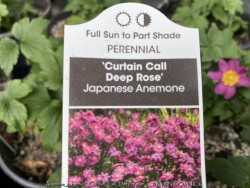

***Description for this perennial available with future update!*** Anemone 'Curtain Call Deep Rose' is also known as Curtain Call Deep Rose Japanese Anemone.
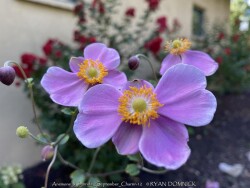

This group of herbaceous perennials are all the result of crossing two or three species, A. hupehensis, A. vitifolium, and A. tomentosa. Many cultivars now exist. Most of which flower white or pink in late summer and fall providing valuable color when many other plants have past their prime. Plants appreciate organically rich, humusy, evenly moist, well-drained soils in morning sun to part shade. Summer moisture leading upto flowering is important to avoid tattered, burnt foliage. Dark green basal growth foliage is semi-evergreen and clump-forming but plants will spread slowly. Anemone x hybrida 'September Charm' is a vigorous hybrid that typically grows to 3-4' tall and provides excellent late summer to early fall bloom from late August to October. Large silvery pink flowers with darker rose shadings and yellow center stamens appear on long, wiry-but-graceful, branching stems over an attractive foliage mound.
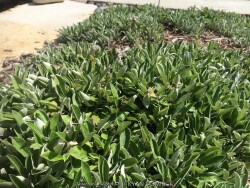

Pussytoes (Antennaria neglecta) are also known for their soft, silvery basal leaves, which spread to form a low groundcover in dry areas. Weeds have a hard time colonizing this groundcover in dry poor soil areas. Absolutely avoid planting pussytoes in moist soils or areas that have poor drainage or death will quickly occur. Native habitat across much of the Midwest and Northeast includes medium to dry black soil prairies, clay prairies, open woodlands and dry meadows. In Kansas landscapes, use as a retaining wall rock garden plant, a stepable groundcover along path, or in-between stepping stones in gravely well drained soils. Pussytoes is named for its white tufted flowers that look like tiny cat's feet. Flowers are interesting but generally best to cut before seed set as they detract from the tidy mat-like foliage. Antennaria neglecta has tiny foliage.
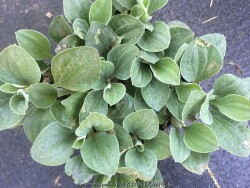

Pussytoes (Antennaria parlinii) are also known for their soft, silvery basal leaves, which spread to form a low groundcover in dry areas. Weeds have a hard time colonizing this groundcover in dry poor soil areas. Absolutely avoid planting pussytoes in moist soils or areas that have poor drainage or death will quickly occur. Native habitat across much of the Midwest and Northeast includes medium to dry black soil prairies, clay prairies, open woodlands and dry meadows. In Kansas landscapes, use as a retaining wall rock garden plant, a stepable groundcover along path, or in-between stepping stones in gravely well drained soils. Pussytoes is named for its white tufted flowers that look like tiny cat's feet. Flowers are interesting but generally best to cut before seed set as they detract from the tidy mat-like foliage. Antennaria parlinii has larger foliage and is more shade tolerant; a great plant for dry-shade.
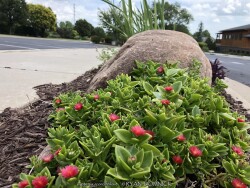

Red Apple Ice Plant (Aptenia / Mesembryanthemum cordifolia) is grown in Kansas as an annual or potted patio plant. Brilliant green glossy leaves contrast magenta flowers all summer! Plant in full sun with dry to average soil. In moist soils, this plant will grow rapidly and bloom less which may be good or bad. Flowers love the sun, but close up at night and remain closed on cloudy days. Plants will flower right up to frost and survive until a hard freeze of 23 degrees F is reached. If growing as a potted plant and trying to overwinter, watch out for scale and mealybugs. To discourage these pests, allow to go partially dormant and keep in a near freezing garage all winter. Cut back any old foliage and stems and place outside in mid-spring in full sun. These pests are never have time to establish in 1 growing season and are rarely a problem when actively growing as an annual in your landscape. Botanical name has recently changed to Mesembryanthemum cordifolium. Also known as Baby Sun Rose or Heartleaf Ice Plant. A variegated form is also available.
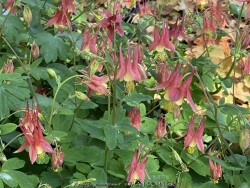

Aquilegia canadensis is a columbine native to Kansas with more tolerance for drought, heat and humidity. It still prefers cool nights preferring rich, moist soils with light to moderate shade. By keep soils uniformly moist after during and after bloom, the attractive foliage will last into June or July in Kansas. When foliage depreciates from drought or leaf miners, the plants may be cut to the ground with some regrowth and flowering possible in the fall. Flowers are reddish pink with yellow shades inside. Great for hummingbirds!
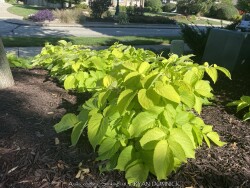

Sun King Aralia (Aralia cordata 'Sun King') is unique golden-leafed variety for the shade. The color will be brighter yellow and gold with pink leaf stalks in part sun, and more chartreuse or lime green in full shade. Tiny white flowers are insignificant and even a distraction to the gorgeous foliage. After blooming, deep purplish black, inedible berries are mildly attractive but not jaw-dropping. This unique perennial grows best in part to light shade tolerating mild drought, though if given consistent moisture it can also grow in mostly full sun. It prefers richly organic, deep loamy soil that is moist but well-drained. It typically dies back to the ground in early fall needing to be cut back then often leaving a late-season void in the garden. It re-emerges in spring to quickly form a beautiful shrub-like clump. Cold tolerance is no problem. It survived -16 degrees F and a week of single digit highs in February, 2021. No disease or pest problems other than late-season foliage decline. In Eastern Kansas, typically our 40 inches of rainfall is sufficient without extra water if planted in good soils. This is a must-have for the shade garden; combine with hostas, solomon's seal, helleborus, or ferns! Also great with shrubs such as boxwood or viburnum.
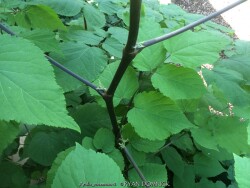

American Spikenard (Aralia racemosa) matures to 3-5' in height and has green flowers with attractive reddish purple berries in early fall. Spikenard is a true herbaceous perennial in that it dies back each fall and emerges from the ground up each spring. So large and broad, it is sometimes confused for a woodland shrub. It prefers wet to medium soil but tolerated dry-shade when mature in rich clay soils. Many woodland plants have already finished flowering when Spikenard blooms and shows off its beautiful berries. Cut the entire plant down in fall as there is no winter interest. In Kansas landscapes, use in Woodland gardens, sun dappled shade gardens, naturalized areas, wild gardens and native plant gardens. Plant as a specimen focal point or small grouping backdrop for shorter plants to contrast in the shade garden.
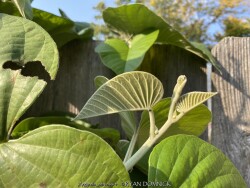

Wooly Morning Glory (Argyreia nervosa) is the most rapidly growing annual vine in out library capable of growing 15-30' in one summer! Native to tropical rainforests of India, it can fill a large trellis or arbor with bright green foliage with silver backs and stems after 1 month. It thrives when planted in May by taking advantage of early summer rains, heat and humidity. It needs typical garden soil and regular moisture. In Eastern Kansas, typically our 40 inches of rainfall is sufficient without extra water in good soils. The flowers are 2-3" across but are usually not present the first year and thus not significant as an annual. It is absolutely gorgeous and wild looking with its foliage alone. If growing as a potted plant and trying to overwinter, it is very difficult as these plants do not like low humidity or low light; best to replace each year.
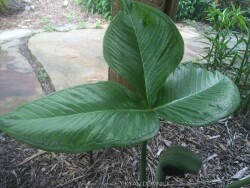

Japanese Cobra Lily (Arisaema ringens) is planted for its bright green foliage and bazaar "Cobra" hood-like flowers. Native to rich Japanese forests in humusy, medium to wet, well-drained soil in part shade to full shade, it needs a good location in the garden and will be a focal point. If foliage depreciates from drought, the plants may be cut to the ground with some regrowth and flowering possible in the fall. Combine with shade garden plants that will fill the space in summer such as hostas. Although this aroid offsetts, it is rare and uncommonly available for sale.
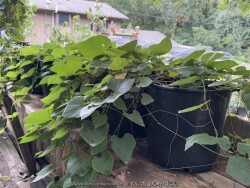

Dutchman's Pipe / Woolly Pipevine (Aristolochia tomentosa) is one of the most rapidly growing vines in out library capable of growing 15-30' in one summer! Native to eastern North America including Missouri, it typically occurs along moist woods and along streams. It can fill a large trellis or arbor with bright green foliage up to 12" across creating the most dense shade of any vine. It needs typical garden soil and regular moisture and is intolerant of drought. In Eastern Kansas, typically our 40 inches of rainfall is close to sufficient without much extra water if planted in good soils. The flowers are 1-2" across but are usually not noticed but is absolutely gorgeous with foliage alone.
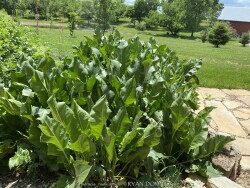

Horseradish (Armoracia rusticana) is a large tropical looking plant features large, variably sized 18-24" long, shiny, dark green leaves (resembling Silphium). It is also a perennial vegetable that is grown for its pungent, fleshy roots which are harvested and grated to make sauces. Insignificant, whitish flowers which appear in summer. Beware that this is an extremely vigorous plant that crowds out most weeds and is itself weed-like, with a very spreading growth habit. Best planted and allowed to grow as large isolated clumps, mowing around it generally stops the yearly spread. Included in our "edibles" plant database section.
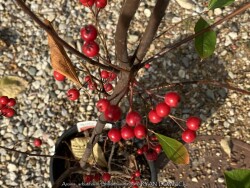

Red chokeberry (Aronia arbutifolia 'Brilliantissima'), is an open, upright, spreading, somewhat rounded but leggy, suckering, deciduous shrub that typically grows 6-10' tall. It is native to native to both wet and dry thickets in Eastern North America. This 3-season shrub had appeal from spring to late fall starting with white flowers, then deep green summer foliage followed by brilliant red fall color and red berries. Plant in groups or mass plantings in small gardens or open woodland areas. Ability to withstand wet conditions makes it suitable for growing on the margins of ponds, streams, or rain gardens. Watch out for deer can devour young plants (protect with chicken wire if needed) but established plantings can generally outgrow deer browsing which offer free pruning to prevent legginess. The common name of chokeberry is in reference to the tart and bitter taste of the fruits which are edible but so astringent as to cause choking in most of those who try: no it's not poison!. Fruits are renowned for its antioxidant rich berries and high nutritional value and sometimes used to make tasty jams and jellies if enough sugar is added. Included in our "edibles" database but depends on how hungry you are! Aronia arbutifolia 'Brilliantissima' grows slowly to 6-8' tall and is perhaps most noted for its attractive glossy red berries and red fall foliage color. It primarily differs from the species by being more compact. It producing more lustrous foliage with superior red fall color. It also produces larger, glossier and more abundant fruit favored by wildlife.
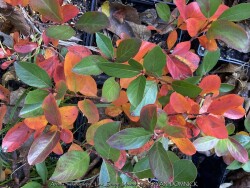

Low Scape Mound Aronia (Aronia melanocarpa 'Low Scape Mound') is a tidy little mound shaped deciduous shrub that typically grows 1-2' tall. It is native to low woods, swamps, bogs and moist thickets native from the Midwest to Canada. This 3-season shrub had appeal from spring to late fall starting with white flowers, then deep green summer foliage followed by brilliant red fall color and a few blackberries. Plant in small groups or mass plantings in small gardens. Ability to withstand wet conditions makes it suitable for growing on the margins of ponds, streams, or rain gardens. Despite 'Low Scape Mound' being touted as "drought tolerant", in the southern part of their range (Kansas), this chokeberry will decline in dry clay or alkaline soils. Watch out for deer and rabbits can devour young plants (protect with chicken wire if needed) but established plantings can generally outgrow browsing. The common name of chokeberry is in reference to the tart and bitter taste of the fruits which are edible but so astringent as to cause choking in most of those who try: no it's not poison!. Fruits are renowned for its antioxidant rich berries and high nutritional value and sometimes used to make tasty jams and jellies if enough sugar is added. Included in our "edibles" database but depends on how hungry you are! However, 'Low Scape Mound' is not grown for fruit production but rather as a compact landscape 3-season shrub tolerant of wet soils. All Proven Winners® plants are legally propagated, healthy and vigorous, true to name, and tagged with color pictures and growing information.
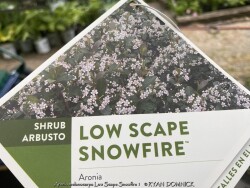

Low Scape Snowfire Aronia (Aronia melanocarpa 'Low Scape Snowfire') compact mound shaped deciduous shrub that typically grows 3-5' tall. It is native to low woods, swamps, bogs and moist thickets native from the Midwest to Canada. This 3-season shrub had appeal from spring to late fall starting with numerous white flowers, then deep green summer foliage followed by brilliant red fall color and a few blackberries. Plant in small groups or mass plantings in small gardens. Ability to withstand wet conditions makes it suitable for growing on the margins of ponds, streams, or rain gardens. Despite 'Low Scape Snowfire' being touted as "drought tolerant", in the southern part of their range (Kansas), this chokeberry will decline in dry clay or alkaline soils. Watch out for deer and rabbits can devour young plants (protect with chicken wire if needed) but established plantings can generally outgrow browsing. The common name of chokeberry is in reference to the tart and bitter taste of the fruits which are edible but so astringent as to cause choking in most of those who try: no it's not poison!. Fruits are renowned for its antioxidant rich berries and high nutritional value and sometimes used to make tasty jams and jellies if enough sugar is added. Included in our "edibles" database but depends on how hungry you are! However, 'Low Scape Snowfire' sets a heavy crop for fruit production but rather as a compact landscape 3-season shrub tolerant of wet soils. All Proven Winners® plants are legally propagated, healthy and vigorous, true to name, and tagged with color pictures and growing information.
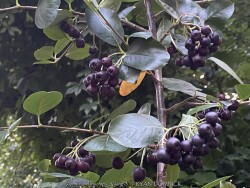

Black Chokeberry (Aronia melanocarpa), is an open, upright, spreading, somewhat rounded but leggy, suckering, deciduous shrub that typically grows 3-6' tall. It is native to low woods, swamps, bogs and moist thickets native from the Midwest to Canada. This 3-season shrub had appeal from spring to late fall starting with white flowers, then deep green summer foliage followed by brilliant red fall color and black berries. Plant in groups or mass plantings in small gardens or open woodland areas. Ability to withstand wet conditions makes it suitable for growing on the margins of ponds, streams, or rain gardens. Watch out for deer can devour young plants (protect with chicken wire if needed) but established plantings can generally outgrow deer browsing which offer free pruning to prevent legginess. The common name of chokeberry is in reference to the tart and bitter taste of the fruits which are edible but so astringent as to cause choking in most of those who try: no it's not poison!. Fruits are renowned for its antioxidant rich berries and high nutritional value and sometimes used to make tasty jams and jellies if enough sugar is added. Included in our "edibles" database but depends on how hungry you are! 'Viking' was developed in Europe for production of extra large dark purple-black fruit also used as a component of health drink juices. Aronia melanocarpa 'Viking' black chokeberry produces abundant fruit and improved fall color. Cross pollination on both varieties increases fruit production although both are self-fertile.
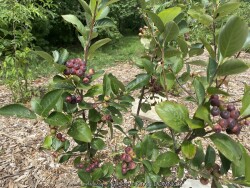

Black Chokeberry (Aronia melanocarpa), is an open, upright, spreading, somewhat rounded but leggy, suckering, deciduous shrub that typically grows 3-6' tall. It is native to low woods, swamps, bogs and moist thickets native from the Midwest to Canada. This 3-season shrub had appeal from spring to late fall starting with white flowers, then deep green summer foliage followed by brilliant red fall color and black berries. Plant in groups or mass plantings in small gardens or open woodland areas. Ability to withstand wet conditions makes it suitable for growing on the margins of ponds, streams, or rain gardens. Watch out for deer can devour young plants (protect with chicken wire if needed) but established plantings can generally outgrow deer browsing which offer free pruning to prevent legginess. The common name of chokeberry is in reference to the tart and bitter taste of the fruits which are edible but so astringent as to cause choking in most of those who try: no it's not poison!. Fruits are renowned for its antioxidant rich berries and high nutritional value and sometimes used to make tasty jams and jellies if enough sugar is added. Included in our "edibles" database but depends on how hungry you are! 'Viking' was developed in Europe for production of extra large dark purple-black fruit also used as a component of health drink juices.
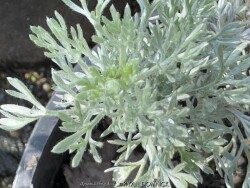

***Description for this perennial available with future update!*** Artemesia frigida is also known as Fringed Sagebrush / Prairie Sagebrush / Wormwood.
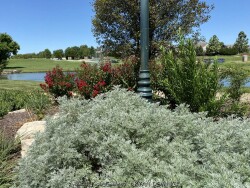

Powis Castle Artemisia (Artemisia 'Powis Castle') beautiful drought tolerant woody perennial valued for its finely dissected, aromatic, silver-gray foliage. It is evergreen down to 0 degrees F, if colder than -5degrees F, woody growth dies back too. Flowering is non-existant. As a perfect companion to vibrant flowering plants and ornamental grasses, it adds unique contrasting color and texture to waterwise landscapes. Most artemisias are best grown in poor to moderately fertile, dry to medium moisture, well-drained soils in full sun. In order to avoid occasional winter-kill in Kansas landscapes, it is advisable to plant on a south, east or west side of house or on south facing slopes or berms. Excellent soil drainage is essential for growing this plant well as poor lanky growth and root rot will occur in moist to wet soils. Tolerant of part-shade if kept dry. Cut back to 3-6" in early spring after dried winter silvery foliage stops looking attractive. New growth will emerge from the crown in mid-spring. If low temperatures hit -10 degrees F, it may kill an un-mulched plant; protect any zone 6 perennial with thick layer of mulch. General foliage decline may occur in hot and humid summer climates of the Southeast US but this is rarely a problem in Kansas or Oklahoma.


Italian Painted Arum (Arum italicum 'Pictum') is native to the Mediterranean region. It has a reversed or off-schedule life cycle; growing when other plants have already shed their leaves to take advantage of sunlight and lack of competition. It is often planted for its unusual evergreen leaf pattern and color resembling a bright green house plant growing outside in winter. Foliage goes dormant by June but is followed by naked stalks emerging from the ground with reddish orange berries. Foliage re-appears in fall and lasts well into winter untouched. If low temperatures hit 0 degrees F, foliage finally dies back to the ground and re-emerges in early spring to repeat the life cycle. If low temperatures hit -15 degrees F, it may kill an un-mulched plant; protect any zone 5/6 perennial with a 2-3" thick layer of mulch. Grow in average to rich well drained garden soil in full sun or full shade with everything in between. Moderate dry shade does not seem to be a problem because arum goes dormant anyways in the heat of summer. This holds true for planting in sunny locations to. Combine with shade garden plants that will fill the space in summer such as hostas or solomon seal. Also great when combined with late-emerging spring perennials (like plumbago, hardy hibiscus, and orange butterfly weed) because it fills that early spring space starting to grow extremely early with freeze-resistant foliage. Then later in the summer when Arum goes dormant, these plants hide the dying foliage and void left in the garden; what a great way for two species to share the same garden space! It has potential to be invasive in parts of the country such as the Pacific Northeast USA but not in Kansas. It is very stable but does not self-seed or spread in Lawrence, KS gardens; bulb offsets develop but only thicken the existing clump over time. Considered to be a great permatanet multi-season perennial for your garden.
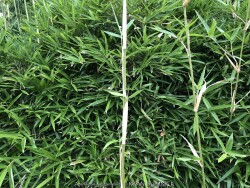

Arundinaria gigantea is also called Canebrake (a tall thicket of any of a variety of Arundinaria) This species, along with its shorter form, 'Tecta', are the only bamboos native to the United States. It once covered huge swaths of rich bottomland along stream valleys and ravines throughout the southeastern United States but have been widely replaced by agriculture. Although still seen in small patches, it can reproduce asexually and rapidly. This adaptation that allows them to persist quietly in the shade of a forest for years and rapidly take advantage of disturbance which disrupts the overstory, such as blowdowns, floods or hurricanes. As a landscape plant, use the same as you would use oriental bamboo in large areas for a evergreen noise, wind, visual screening. Foliage is evergreen to 0 to 5 degrees F. Canes will defoliate at -5 to -10 degrees F. Canes die to the ground at -10 to -15 degrees. Root system will survive up to -25 to -30 degrees F as a perennial especially if mulched. Arundinaria gigantea usually grows 10-15' feet tall in Kansas. Every few years a grove will experience complete winterkill: it is strongly advised to cut all dead growth to the ground for aesthetic reasons and and fire prevention. The 'Tecta' form looks similar but only grows 6-8 feet tall and is tolerant of wet soil.
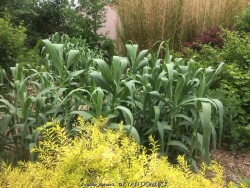

Giant Reed Grass (Arundo donax) is a giant perennial grass that can reach up to 20 ft. in height in Kansas in average to wet soils. Although it can be much shorter in full to part shade or very dry soils. The overall look is tropical like resembling giant corn. Flowering occurs in late summer to early fall, when plants are most easily recognized because of the large, dense flower plumes (upto 3' long) that develop at the tops of the culms. Arundo donax is native to India and spreads through rhizomes and stem nodes that come in contact with the soil. If low temperatures hit -10 degrees F, it may kill an un-mulched plant; protect any zone 6 perennial with thick layer of mulch. It has potential to be invasive in parts of the country but not so much in Kansas as cold winters prevent this plant from self-seeding and taking over ecosystems. Maintenance can be quite a yearly chore cutting back 20' tall cans each year; we recommend a chainsaw, heavy-duty loppers, and a large burn pit. Canes pop (but don't spark) when burning in bonfires! Make your very own firework sound effects; lots of fun with our kids! Cut-back is best in the fall because canes shed leaves stalks making a mess when winter winds blow. For the home garden, the species is generally too aggressive to mix with other plants or near the house: plan on its use as a screening plant and allow at least a 10'x10' area. One of the best plants for screening busy highways in rough non-irrigated areas.
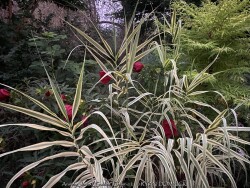

Golden Chain is a dwarf Giant Reed Grass cultivar (Arundo donax 'Golden Chain') is a perennial grass that can reach up to 8 ft. in height in Kansas in average to wet soils. Although it can be much shorter in part shade or very dry soils. The overall look is tropical like resembling corn. Flowering occurs in late summer to early fall, when plants are most easily recognized because of the large, dense flower plumes (upto 2' long) that develop at the tops of the culms. Arundo donax is native to India and spreads through rhizomes and stem nodes that come in contact with the soil. If low temperatures hit -10 degrees F, it may kill an un-mulched plant; protect any zone 6 perennial with thick layer of mulch. The non-variegated species has potential to be invasive in parts of the country but not so much in Kansas as cold winters prevent this plant from self-seeding and taking over ecosystems. Cut-back is best in the fall because canes shed leaves stalks making a mess when winter winds blow. Canes pop (but don't spark) when burning in bonfires! Make your very own firework sound effects; lots of fun with our kids! For the home garden, Golden Chain Dwarf Giant Reed Grass is much less aggressive than the species; you can mix it with other plants near the house or in rain gardens. Large clumps have been stable in our Lawrence, KS (zone 6a) display garden for over 5 years; spread is quite slow and manageable.
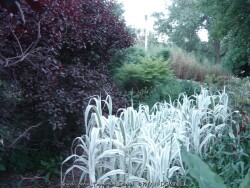

Golden Chain is a dwarf Giant Reed Grass cultivar (Arundo donax 'Golden Chain') This arundo cultivar (Arundo donax 'Peppermint Stick') is a perennial grass that can reach up to 12 ft. in height in Kansas in average to wet soils. Although it can be much shorter in full to part shade or very dry soils. The overall look is tropical like resembling giant corn. Flowering occurs in late summer to early fall, when plants are most easily recognized because of the large, dense flower plumes (upto 3' long) that develop at the tops of the culms. Arundo donax is native to India and spreads through rhizomes and stem nodes that come in contact with the soil. If low temperatures hit -10 degrees F, it may kill an un-mulched plant; protect any zone 6 perennial with thick layer of mulch. The non-variegated species has potential to be invasive in parts of the country but not so much in Kansas as cold winters prevent this plant from self-seeding and taking over ecosystems. Cut-back is best in the fall because canes shed leaves stalks making a mess when winter winds blow. Canes pop (but don't spark) when burning in bonfires! Make your very own firework sound effects; lots of fun with our kids! For the home garden, Peppermint Stick Giant Reed Grass is less aggressive than the species; you can mix it with other plants near the house or in rain gardens. Peppermint Stick maintains it's variegation unlike older variegated cultivars and does not revert or fade to green! Large clumps have been stable in our Lawrence, KS (zone 6a) display garden for over a decade; spread is quite slow and manageable.
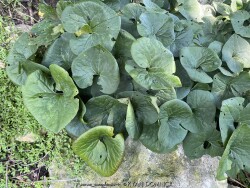

Wild Canadian Ginger (Asarum canadensis) is planted for its unusual kidney-shaped leaf pattern and bright green color. Foliage maintains well all summer provided that certain cultural conditions are met. Native to the Northern US and as far south as Missouri, it slowly colonizes forests in humusy, medium to wet well-drained soil in part shade to full shade. It can handle a little Kansas drought in in moisture-retentive soils but not dry-shade. Foliage will flatten to the ground during drought then spring back up when moisture is available again. In ideal sites, Canadian Ginger can form a dense, weed resistant groundcover in small areas. Flowers are quite attractive but usually hidden from view by the foliage. Although not related to culinary ginger (Zingiber officinale), the roots of this plant produce a scent that is reminiscent thereof. This plant is edible, however, is not normally used today for culinary purposes. Very popular in the native woodland garden in Kansas gardens and worth planting more in ideal locations.
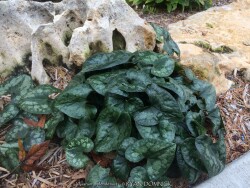

Chinese Wild Ginger (Asarum splendens) is planted for its unusual evergreen leaf pattern and color resembling a bright green house plant growing outside in winter. Foliage maintains well all year provided that certain cultural conditions are met. Native to Chinese forests in humusy, medium well-drained soil in part shade to full shade, it needs constantly moist soil rich in organic matter but avoid clay. If low temperatures hit -10 degrees F, foliage finally dies back to the ground and re-emerges in early spring. Generally this plant declines after a few years of Kansas climate but worth a try in perfect soils in well-tended shade gardens.
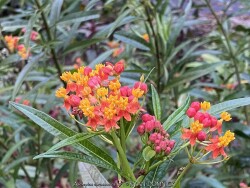

***Description for this plant available with future update!*** Asclepias curassavica is also known as Tropical Milkweed (Tropical).
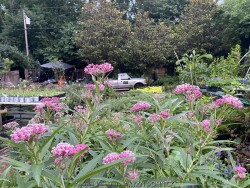

Pink Swamp Milkweed (Asclepias incarnata) is a herbaceous perennial plant species native to North America. The foliage is bright green and upright. The blooms occurring in early to mid-summer are pink to mauve (sometimes white). After blooming, green seed pods are attractive. They finally split open in late summer releasing silver fluffy floating seeds that are whisked away in the wind. This same natural mechanism for seed dispersal is similar to that used by most other milkweed (Asclepias) species. Fall color is an attractive yellow to gold with red highlights. It is frequently grown as a bog plant needing constantly moist soil rich in organic matter. As a rain garden plant, it will thrive is a depressed area in the landscape that collects rain water from a roof during spring and summer periods of rain but then go dormant if the water hole dries out completely. This species is not shade-tolerant and will get crowded out if the rain garden becomes too dense. Pink Swamp Milkweed may also be grown in average garden soils provided extra water is supplied during droughts. It is cultivated as a garden plant for butterflies and birds at all life stages: foliage for caterpillars, nectar for butterflies and other insects, and seeds for birds. It has a latex sap containing toxic chemicals that helps it repel other insects and other herbivorous animals. In the home landscape, this species does not spread like some other milkweeds. The plant is also timid about self-seeding because seeds have to germinate in mud and quickly die if it dries out. No worries about invasiveness with this one, just count on it being a beautiful tall perennial for many years in the garden! The species is not shade-tolerant and is not a good vegetative competitor.


Pink Swamp Milkweed (Asclepias incarnata) is a herbaceous perennial plant species native to North America. The foliage is bright green and upright. The blooms occurring in early to mid-summer are pink to mauve (sometimes white). After blooming, green seed pods are attractive. They finally split open in late summer releasing silver fluffy floating seeds that are whisked away in the wind. This same natural mechanism for seed dispersal is similar to that used by most other milkweed (Asclepias) species. Fall color is an attractive yellow to gold with red highlights. It is frequently grown as a bog plant needing constantly moist soil rich in organic matter. As a rain garden plant, it will thrive is a depressed area in the landscape that collects rain water from a roof during spring and summer periods of rain but then go dormant if the water hole dries out completely. This species is not shade-tolerant and will get crowded out if the rain garden becomes too dense. Pink Swamp Milkweed may also be grown in average garden soils provided extra water is supplied during droughts. It is cultivated as a garden plant for butterflies and birds at all life stages: foliage for caterpillars, nectar for butterflies and other insects, and seeds for birds. It has a latex sap containing toxic chemicals that helps it repel other insects and other herbivorous animals. In the home landscape, this species does not spread like some other milkweeds. The plant is also timid about self-seeding because seeds have to germinate in mud and quickly die if it dries out. No worries about invasiveness with this one, just count on it being a beautiful tall perennial for many years in the garden! The species is not shade-tolerant and is not a good vegetative competitor.
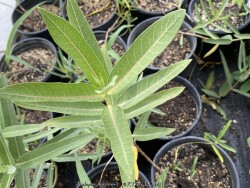

***Description for this perennial available with future update!*** Asclepias speciosa is also known as Showy Non-Spreading Milkweed.